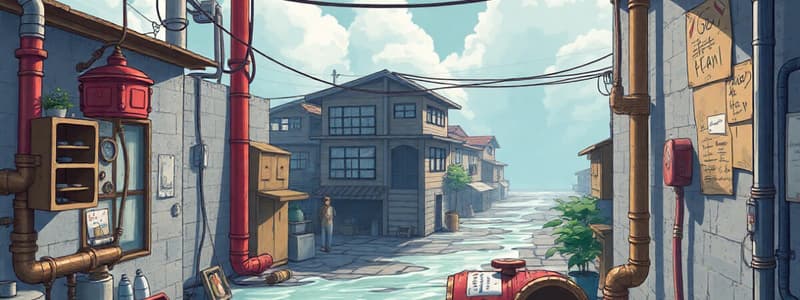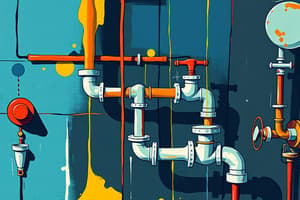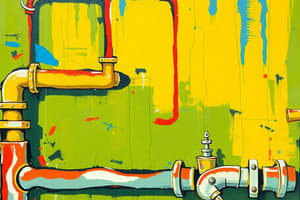Podcast
Questions and Answers
What is plumbing?
What is plumbing?
The art and technique of installing pipes, fixtures, and other apparatuses in buildings for bringing in the supply of liquids and removing them.
In which year was the Plumbing Trade recognized by the government in Manila?
In which year was the Plumbing Trade recognized by the government in Manila?
- 1999
- 1955
- 1902 (correct)
- 1935
The Plumbing Code of the Philippines was based on the Plumbing Code of the United States.
The Plumbing Code of the Philippines was based on the Plumbing Code of the United States.
True (A)
Who was the first Chief of the Division of Plumbing Construction and Inspection?
Who was the first Chief of the Division of Plumbing Construction and Inspection?
What is the minimum requirement for plumbing fixtures in each family dwelling unit according to the plumbing principles?
What is the minimum requirement for plumbing fixtures in each family dwelling unit according to the plumbing principles?
What should plumbing fixtures be made of to ensure proper sanitation?
What should plumbing fixtures be made of to ensure proper sanitation?
What protection should be provided to prevent contamination of food and water?
What protection should be provided to prevent contamination of food and water?
Flashcards are hidden until you start studying
Study Notes
Definition of Plumbing
- The installation of pipes, fixtures, and other apparatuses in buildings to bring in water and remove waste
- The art and technique of bringing in the supply of liquids, substances and/or ingredients and removing them
- Also refers to the pipes and fixtures after installation, known as the ‘plumbing system’
History of Plumbing in the Philippines
- In 1902, the Plumbing Trade was recognized by the government in Manila
- Master Plumber John F. Haas became the first Chief of the Division of Plumbing Construction and Inspection
- A Plumbing Code based on the United States Plumbing Code was incorporated into the Building Code for Manila
- In 1935, the National Master Plumbers Association of the Philippines (NAMPAP) was formally organized
Manila City Ordinance 2411
- Enacted as the “Plumbing Code for the City of Manila”
- Placed under the Department of Public Services, Manila
- Introduced in 1954
Republic Act No. 1378 (1955)
- Known as the “Plumbing Law of the Philippines”
- Ratified by President Ramon Magsaysay
- Approved by the Third Congress in 1954
National Plumbing Code (1959)
- Prepared by the NAMPAP
- Promulgated and approved by Malacañang
- Incorporated into the “Building Code of the Philippines”
Revised Plumbing Code of 1999
- Adopted by the Professional Regulation Commission (PRC)
- Approved by President Joseph Estrada in 1999
- Based on Republic Act No. 1378, known as the Plumbing Law
22 Basic Principles of the Plumbing Code
- All premises intended for human use or habitation shall be provided with a supply of pure and wholesome water
- Plumbing fixtures, devices, and appurtenances shall be supplied with water in sufficient volume and pressure
- Plumbing shall be designed and adjusted to utilize the minimum amount of water
- Devices for heating and storing water shall be designed to prevent dangers from explosion through overheating
- Every building abutting on a street, alley or easement with a public sewer shall connect its plumbing fixtures to the system
- Each family dwelling unit shall have at least one water closet, one kitchen type sink, a lavatory, and a bathtub or shower
- Plumbing fixtures shall be made of smooth non-absorbent material and located in ventilated enclosures
- The drainage system shall be designed, constructed, and maintained to safeguard against fouling, deposit of solids, clogging, and with adequate cleanouts
- All piping shall be of durable NAMPAP-APPROVED materials, free from defective workmanship, designed and constructed by Registered Master Plumbers
- Each fixture directly connected to the drainage system shall be equipped with a water-sealed trap
- The drainage pipes piping system shall be designed to provide adequate circulation of air
- Vent terminals shall extend to the outer air and installed to prevent clogging and the return of foul air to the building
- Plumbing systems shall be subjected to tests to effectively disclose all leaks and defects
- Substance which will clog the pipes, produce explosive mixtures, destroy the pipes or their joints or interfere unduly with the sewage-disposal process shall not be allowed to enter the system
- Proper protection shall be provided to prevent contamination of food, water, sterile goods by backflow of sewage
- No water closet shall be located in a room or compartment which is not properly lighted
Studying That Suits You
Use AI to generate personalized quizzes and flashcards to suit your learning preferences.




